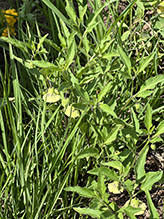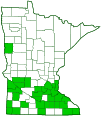longleaf groundcherry
(Physalis longifolia)
Overview • Description • Distribution • Taxonomy
There are two generally recognized varieties of longleaf groundcherry: var. subglabrata in the east and var. longifolia in the west. Where the two varieties occur together, including in southern Minnesota, there is considerable overlap in characteristics, making identification of the variety difficult. |
||
Description |
||
Longleaf groundcherry is a perennial, 16″ to 32″ (4 to 8 dm) tall forb. Stems are stout, erect or ascending, and branched. They are often tinged purplish and are either hairless or sparsely covered with very short, upward appressed, nonglandular hairs. Leaves are alternate and are on 4″ to 10″ (10 to 25 cm) long leaf stalks (petioles). Leaf blades are unlobed, narrowly lance-shaped to egg-shaped, 1¼″to 3½″ (3 to 9 cm) long and ⅜″ to ¾″ (1 to 2 cm) wide. They may be thick and firm or thin. The margins may be mostly toothless (entire) or have a few irregular, wavy (sinuate) teeth. The leaves may be hairless or be sparsely covered with minute, appressed, nonglandular hairs. The inflorescence is single flowers nodding at the end of 5⁄16″to ½″ (8 to 12 mm) long, minutely hairy stalks (pedicels) rising from the leaf axils. The flowers are ½″ to ¾″ (12 to 20 mm) long and wide. The corolla is bell-shaped and yellow with purple to brown splotches near the center. The cup-like group of outer floral leaves (calyx) is hairless or is sparsely covered with minute, upward appressed, nonglandular hairs. The anthers may be yellow, blue, or gray. The fruit is a ¼″ to ½″ (6 to 12 mm) in diameter, spherical berry enclosed in an egg-shaped, papery, ⅜″ to 1½″ (1 to 4 cm) long husk. It hangs downward from a ⅝″ to 1⅜″long pedicel. |
||
Distribution |
||||
|
Sources |
|||
| 10/1/2023 | ||||
Taxonomy |
|||
| Kingdom | Plantae (green algae and land plants) | ||
| Subkingdom | Viridiplantae (green plants) | ||
| Infrakingdom | Streptophyta (land plants and green algae) | ||
| Superdivision | Embryophyta (land plants) | ||
| Division | Tracheophyta (vascular plants) | ||
| Subdivision | Spermatophytina (seed plants) | ||
| Class | Magnoliopsida (flowering plants) | ||
| Superorder | Asteranae | ||
Order |
Solanales (nightshades, bindweeds, gooseweeds, and allies) | ||
Family |
Solanaceae (nightshade) | ||
| Subfamily | Solanoideae (nightshades and allies) | ||
| Tribe | Physaleae (groundcherries, lanterns, and allies) | ||
| Subtribe | Physalinae | ||
Genus |
Physalis (groundcherries) | ||
Subordinate Taxa |
|||
longleaf groundcherry (Physalis longifolia var. longifolia) longleaf groundcherry (Physalis longifolia var. subglabrata) |
|||
Most authors recognize two varieties, var. subglabrata and the nominate variety, var. longifolia. A third variety, var. texana, has been described but it is not widely recognized. Some authors treat var. subglabrata as a distinct species, Physalis subglabrata. |
|||
Synonyms |
|||
Physalis macrophysa Physalis polyphylla Physalis pumila var. sonorae Physalis rigida Physalis virginiana var. longiseta Physalis virginiana var. polyphylla Physalis virginiana var. sonorae |
|||
Common Names |
|||
common ground cherry common ground-cherry common groundcherry long-leaf ground-cherry long-leaf groundcherry long-leaved ground-cherry long-leaved groundcherry longleaf groundcherry longleaf ground-cherry wild tomato |
|||
Glossary
Axil
The upper angle where a branch, stem, leaf stalk, or vein diverges.
Calyx
The group of outer floral leaves (sepals) below the petals, occasionally forming a tube. Plural: calyces.
Corolla
A collective name for all of the petals of a flower.
Pedicel
On plants: the stalk of a single flower in a cluster of flowers. On insects: the second segment of the antennae. On Hymenoptera and Araneae: the narrow stalk connecting the thorax to the abdomen: the preferred term is petiole.
Petiole
On plants: The stalk of a leaf blade or a compound leaf that attaches it to the stem. On ants and wasps: The constricted first one or two segments of the rear part of the body.
Rhizome
A horizontal, usually underground stem. It serves as a reproductive structure, producing roots below and shoots above at the nodes.
Visitor Photos |
|||||
Share your photo of this plant. |
|||||
| This button not working for you? Simply email us at info@MinnesotaSeasons.com. Attach one or more photos and, if you like, a caption. |
|||||
Nancy Falkum |
|||||
Physalis longifolia Ground cherry at TNC Cox Unit |
|||||
 |
|||||
MinnesotaSeasons.com Photos |
|||||
|
|||||

Slideshows |
||

Visitor Videos |
|||
Share your video of this plant. |
|||
| This button not working for you? Simply email us at info@MinnesotaSeasons.com. Attach a video, a YouTube link, or a cloud storage link. |
|||
Other Videos |
|||

Visitor Sightings |
|||||
Report a sighting of this plant. |
|||||
| This button not working for you? Simply email us at info@MinnesotaSeasons.com. Be sure to include a location. |
|||||
| Nancy Falkum 6/16/2022 |
Location: Weaver Dunes Preserve, Cox Unit, 126th Avenue off 598th Street off Wabasha County 84. Physalis longifolia Ground cherry at TNC Cox Unit |
||||
MinnesotaSeasons.com Sightings |
|||||
|
|||||

Created: 10/1/2023
Last Updated:

